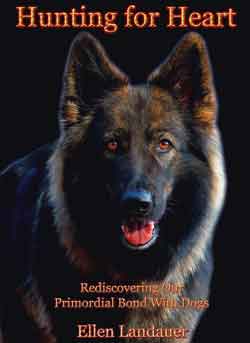Puppy Training Timeline
by Ellen Landauer
A puppy training timeline needs to above all, be realistic, individualized and to honor the true nature of your dog.
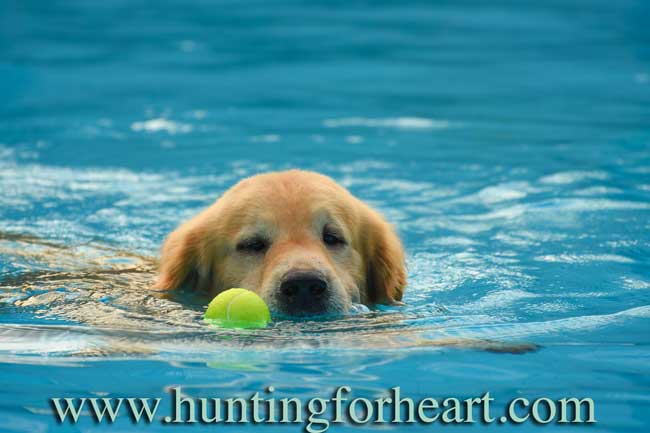
Puppy training timeline: Far too many people think it should look something like this:
Between 8 - 12 weeks of age:
Good start on housebreaking - pup sleeps through night.
Teach them their name through lots of repetition.
Teach them what 'NO' means.
Give them 'a little freedom' in the house and keep your eye on them - this provides many opportunities to teach what 'NO' means.
Get them used to a collar and leash.
Begin obedience training - start teaching 'heel,' 'sit,' 'stay,' 'come,' etc.
Attend a 'puppy kindergarten' class.
Bite inhibition - reprimand them for putting their mouths on ANYONE, especially children - start slowly with mild discipline and escalate as needed.
Socialize them - take them as many places as possible and let them interact with all manner of people, animals and environments.
When socializing with older dogs, allow older dogs to discipline the pup because they 'need to respect their elders.'
You will find that the vast majority of breeders, rescue organizations and dog trainers will tell you to do ALL of the above, with special emphasis on so-called 'socialization' (why would you need to 'socialize' the most social animal on earth)?!
Puppy Training Timeline:
12 Weeks - 6 Months
Keep taking them everywhere and socialize constantly. Allow and encourage all manner of people, especially children to interact with your pup.
Let anyone move toward your pup or call them to come, reach toward them, grab them, give them eye contact, petting and hugs. Ignore any signs that your pet doesn't like this. Keep insisting your pup be totally compliant and submissive with everyone.
A puppy training timeline includes formal obedience training; take a group class and learn how to mold behavior into all the obedience commands.
Teach them to give you attention and eye contact.
Get more aggressive about enforcing 'no bite.' Give them lots of toys to chew on.
Give them copious amounts of exercise to tire them and make them more amenable to behaving.
'Socialize' them some more...
1 - 2 years of age:
Dog should be excellent in the house.
They should be submissive and well-behaved around all people and animals.
Obedience should be excellent even off-lead with distractions.
My take on all the above - NO, NO and NO!
The LESS of this life-negative 'training' you do, the more you benefit EVERYONE (and particularly your dog)!
Read to bottom of page for some healthy alternatives to the conventional puppy training timeline.
PHOTOS BELOW: Dog raised fully in accordance with Natural Dog Training principles.
As a pup on left. Same dog seven years later. Same openness in eyes and face, same big fat nose (no tension around mouth). Same smooth, relaxed forehead...
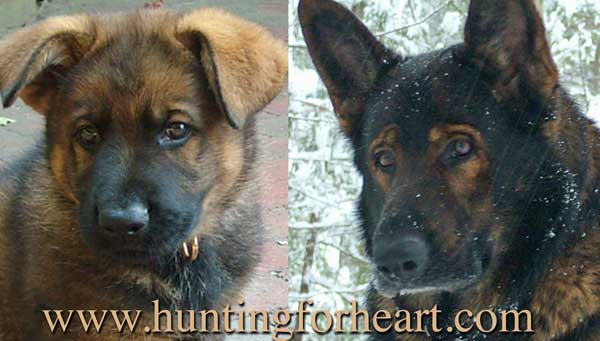
My mentor, Kevin Behan, always said, 'The more of the little puppy that lives in the grown dog, the better.'
Why..?
Have you noticed how open, emotionally flexible and available a little pup is? When those qualities thrive in a grown dog, enhanced by greater refinement and resilience imparted by maturity - YOU HAVE ONE HELLUVA GREAT DOG!
Puppy Training Tiimeline:
Individual Differences
A puppy training timeline should take individual differences into account.
Did you know that large working breeds such as Eastern European German Shepherds and Rottweilers can take 4 - 6 years to fully mature? Jack Russell terriers, King Charles Spaniels and other smaller dogs generally mature at around 1 1/2 years.
Examples of individual differences:
- Potty training commonly is faster with females than with males.
- Small breeds tend to mature faster than large breeds.
- High-drive dogs can take longer than dogs that are more laid-back.
Another variable is the experience, knowledge and temperament of the owner.
Puppy Training Timeline Pressures
Why do We Insist They Grow up too Fast?
Ah - the pressures we put on our baby pups to learn all the commands, 'understand' every spoken word, to be intellectually brilliant. 'He thinks he's a person.' 'She already knows 25 words and she's only 2 months old!'
Doubtless, you've seen parents do this with their young children. Most of this is ego-driven. I was as guilty of this years ago, as anyone else. We want to think our child or puppy is exceptional, and since intellect is so overvalued, we want to think they are the 'smartest.'
This pressure is put on far too many dogs and children. They are micro-managed from day one. Intellect is valued over emotional wholeness. Fostering a deep-level development of perceptiveness, and abilitiy to access heart and feeling in both children and puppies, is sadly lacking - not even a concept for many.
By 'heart and feeling,' I am speaking about the part of us that KNOWS. It is that 'still, small voice' that - if we are awake enough to hear it, and trusting enough in its wisdom - tells us right from wrong in any situation, warns us of danger, helps us find our way in life and in the moment.
Our modern preoccupation with intellect is pathological. Whatever happened to the deeper, slower, more organic way of allowing temperament to naturally unfold in all its magnificence? Both dogs and children can benefit from this. They then grow up more confident, composed, trustworthy and strong.
What has happened to taking time to be in harmony on a deeper level? We are so obssessed with 'performance,' looking good to others - that we miss the magic of Heart, of feeling.
Kevin Behan always said, 'Dogs 'know us by Heart.'
Puppy Training Timeline:
The Natural Dog Training Approach
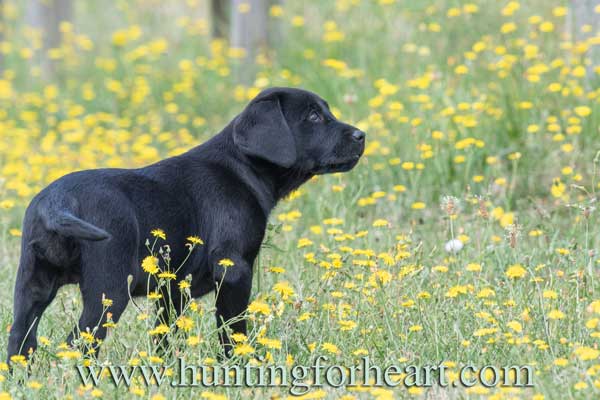
A pup will develop in a more healthy way if we do the following:
1 - STOP worrying what EVERYONE ELSE thinks of your pup! Hopefully, you didn't bring this pup into your life to impress anyone! It is easy to deny this - but if there is some truth to it, acknowledge that. Consider how this may be affecting your natural connection with your dog. My experience tells me that both you and your dog will suffer if egotistical motives get in the way of real emotional connectedness.
2 - Put your pup's well-being first, before allowing them to be used for the ego-gratification of others. This means giving them a calm environment and making sure people (with all their good intentions) do not IMPOSE their presence on your pup.
YOU are your pup's advocate! How well you advocate for them will determine how magnificently (or not) they manifest their prodigious social nature when grown.
Adults and children alike should be told ahead of time to maintain a neutral composure. Anyone who interacts with your pup should NOT encourage pup in any way to come to them, stay with them.
The usual ways people interact with pups is perceived as pressure by a pup AND - DIMINISHES a dog's responsiveness and natural attraction to humans.
FOR EXAMPLE: Calling them and trying to attract attention so they will come - is perceived as pressure by a pup.
I assure you 100% that by allowing anyone to call your pup you are training your pup NOT to come when called!
ALSO - Never let people move toward pup - instruct people to either stand still or turn and walk away. Moving AWAY from the pup is a GREAT way to attract them!
3 - Confidence-building exercise for your pup: After ensuring that everyone understands 'calm and neutral,' you can do a 'getting acquainted exercise' Natural Dog Training style. Get some lawn chairs out and have your guests sit 6 - 10 feet apart on the lawn - they are to stay sitting calmly and keep looking straight ahead with eyes soft (no staring at pup). Your guests' backs should be turned to where your pup will enter the scene.
Let pup out of the house and allow them to investigate everyone freely. If pup jumps up on someone, that is very good - it shows contactfulness on the part of the pup. This WON'T lead to jumping problems in the future; later you will channel that energy so it's not a problem. Just instruct person to gently and firmly massage pup's back and shoulders then let pup go to next person.
Once pup is happy and content, let your guests one at a time get off chairs and kneel down. After pup goes to investigate that person, have another person get off their chair and repeat the process. If the pup does not check out all your visitors, no problem.
Next, you and your guests take a walk around the yard or in safe secluded woods and allow pup to follow along. Your visitors should not do anything to attract the pup; ALL initiative should come from the pup.
If pup forges ahead, do NOT allow anyone to move faster to 'catch up.' If pup goes too far away, the group should turn around and walk in the opposite direction. By moving away, the group has becom more 'preylike' and pup most likely will follow. Pups under 12 weeks old will tend to stay fairly close.
Once back home, bring pup inside to their crate (in a quiet room) and have a nice visit with your guests in another part of the house. Tell the kids the pup needs time alone and to take a nap - likely very true.
Major benefit for your pup's emotional (and physical) health will accrue if you follow these recommendations.
4 - 'I never let anyone call my puppy to them. Puppies perceive being called as pressure - energetically it drives them away. By calling the pup, we are teaching them to not come when called.' - Kevin Behan
Pups are infatuated with us - madly in love - why mess up this pure, natural attraction?
One absolute rule is to ALWAYS let your pup initiate ALL contact - with YOU and everyone else. Do not let people call your pup to them, move toward them, reach for them or pick them up.
Yes - this goes against everything everyone is saying out there. (I assume you are reading this because you want to find a better way). If not, fine, it is your right to raise a pup by whatever method you wish...
5 - Unless it is an emergency, do NOT pick up your pup or allow anyone else to do so!
Except in a case of a pup or small dog that is about to be attacked by a larger one, or a dog in immediate danger in some other way, it is best not to lift a pup into the air.
Why? It tends to be frightening for them.
Most people don't notice this, as a lot of pups go limp when picked up - this is a survival strategy, as a predator is more likely to lose interest in prey that appears 'dead.'
All pups and dogs prefer to get from one place to another with all four feet on the ground.
6 - Allow your pup's natural attraction to people to flourish in all its delightful ways.
Arranging things so THEY are the one to move toward people of their own accord will allow that attraction to grow as your pup matures. This will also contribute to greater confidence and composure. Use food, toys and moving away from the pup to draw them to you, or direct them into their crate when you bring them indoors.
7 - Your pup loves you without question. Even if they do something you don't like, the love is always there - you just may not be perceiving it if your ego is hurt. If you doubt their love, and smother them with YOUR 'love,' it will only drive them away. (Think how you would feel as a child being smothered in love by a parent. You would go into avoidance, and maybe even lash out in anger to get them to give you some space).
Give your pup plenty of emotional space and let them make the moves.
8 - Don't put your pup in a situation where you will find you need to reprimand them. If you do, they will see you as the problem, as interfering with their fun (chewing things or eliminating in the house). Crate them when they are indoors.
9 - Channel their drive OUTDOORS. Especially with a young pup, don't encourage play indoors. They will learn to see indoors in the crate as a calm resting place.
As your pup matures, with your support, they will gradually extend 'resting place' status to the whole house, and even other people's homes. That's what you want, isn't it? You don't want lamps toppling, rugs chewed, couches muddied, etc., because your pup thinks your house is an amusement park - right?
Outdoors is the time to explore the yard or woods and fields together, to play tug, to channel energy with food and eventually with Natural Dog Training character-building exercises.
10 - If family and friends want to meet your pup, take a walk together outdoors. This is a much less confined, pressured environment than indoors and pup will be much more relaxed and confident which is good for everyone.
DO NOT INTRODUCE YOUR PUP TO PEOPLE INDOORS. Indoors is a more compressed (close quarters) environment than outdoors. This creates more stress for the pup. They are more likely to pee or nip, etc. because they are not as relaxed as they would be in a safe open space outside.
Set the rules for EVERYONE - no calling pup, no chasing pup, no grabbing at pup. Pup comes to them and if the pup wants to move away, let them.
If children are involved, make sure they are very clear not to screech and be overactive. A child with composure is a good companion for a pup to meet. Children that are noisy, hyper and cannot interact with puppies in a calm way can traumatize a pup.
Your pup will be much better around both grownups and kids when grown when you follow the recommendations provided on this page.
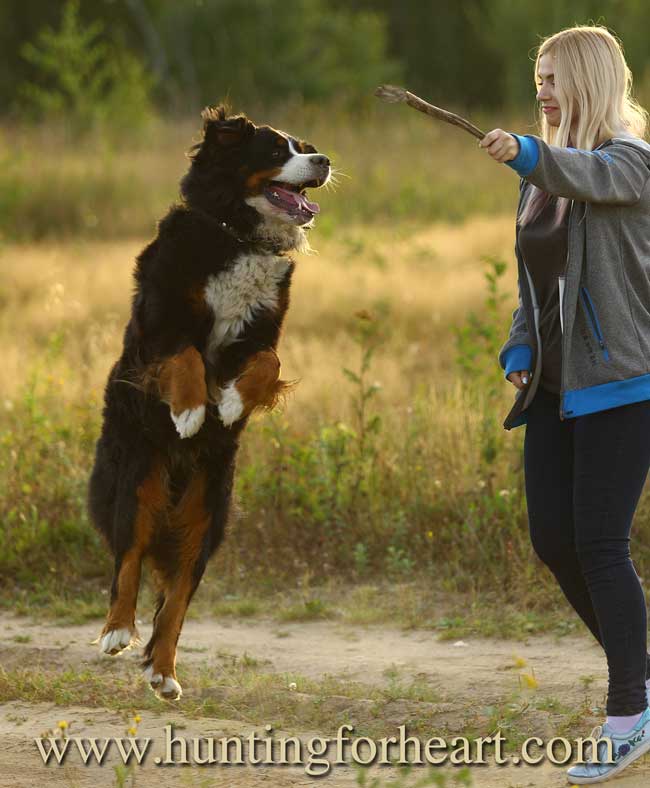
The added benefit, is when a natural, individualized puppy training timeline is your guide, the result will be a grown dog who is happier than most, calmer than most and a joy to live with!
BUY 'Hunting for Heart' and
Rediscover Your Primordial Bond With Dogs
BUY the
Book
HEALTH INFO
FOR YOU
My other website:
Peak health helps you have more energy to enjoy your dog!
